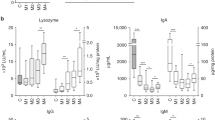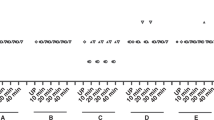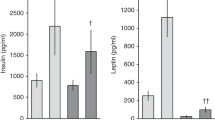Abstract
Preterm infants can inoculate virulent cytomegalovirus (CMV) through their mothers' raw breast milk. Complete virus inactivation is achieved only by heat treatment, but the effect on growth factors has never been assessed systematically. Insulin-like-growth-factor-1-, IGF-2-, insulin-like-growth-factor-binding-protein-2-, and IGFBP-3-concentrations were measured, before and after heating, in 51 breast-milk-samples from 28 mothers, and epidermal-growth-factor-concentrations in a subgroup of 35 samples from 22 mothers. Two heating methods were applied: Short-term (5 s) pasteurisation at 62, 65, and 72°C, and long-term Holder-Pasteurisation (30 min) at 63°C. IGF-1, IGF-2, IGFBP-2, and IGFBP-3 were measured by RIA, and EGF by ELISA. Heating for 30 min decreased significantly IGF-1 by 39.4%, IGF-2 by 9.9%, IGFBP-2 by 19.1%, and IGFBP-3 by 7.0%. In contrast, IGF-1, IGF-2, IGFBP-2, and IGFBP-3 were not altered significantly when using a short heating duration of 5 s, irrespective of the level of temperature, except for IGF-2 at 62°C for 5 s (p = 0.041) and IGFBP-2 at 72°C for 5 s (p = 0.025). Neither long- nor short-time heating methods changed the concentration of EGF. Only short heating methods (5 s, 62–72°C) can preserve, almost completely, the concentrations of IGFs in human milk, whereas Holder-Pasteurization does not.
Similar content being viewed by others
Main
Preterm infants are at risk of acquiring Cytomegalovirus (CMV) infection in their first weeks of life through their mothers' raw breast milk, because CMV-IgG-positive mothers reactivate the virus during lactation and excrete it into their breast milk (1,2). For total inactivation of CMV in breast milk, heating procedures are necessary. Freeze-thawing may reduce the virus count but does not eliminate virulent CMV completely (3–5). There is growing evidence that, in addition to conventional Holder pasteurization (63°C, 30 min), short-term heat inactivation methods are effective (1,3; Müller, D [Establishing of a new procedure for the short-time heat pasteurization for inactivating of human Cytomegalievirus in mother's milk]. Doctoral thesis 2006 at The Medical Faculty of the Eberhard-Karls-University of Tuebingen). However, the effect of the duration of heating and the temperature level achieved on bioactive substances like insulin-like growth factors (IGF), insulin-like growth factor binding proteins (IGFBP), and epidermal growth factor (EGF) in human milk has not yet been assessed systematically. We, therefore, evaluated the concentrations of growth hormones in human breast milk before and after processing with different heat inactivation parameters.
METHODS
Milk samples.
IGF-1, IGF-2, IGFBP-2, and IGFBP-3 were analyzed in 51 freshly expressed breast milk specimens from 28 mothers; 21 of preterm and 7 of term infants. The expressed milk specimens, originating from lactation day 5–46, were stored at −20°C soon after collection until use. For processing, they were thawed, aliquoted, and labeled as either control or treated. The latter were heated according to four different protocols, and then the whey fraction was separated from milk using two centrifugation steps (1500 rpm, 10 min, 20°C, and 4000 rpm, 10 min, 20°C). This was followed by a filtration step (20 μm). Resulting samples were then stored at −20°C until analysis. In 35 of the 51 milk samples (17 from mothers of preterm and five of term infants), EGF could also be analyzed. Informed consent was obtained from all mothers. The study was approved by the ethics committee of the University Hospital Tuebingen.
Heat inactivation.
The four inactivation protocols consisted of three short heat inactivations with a duration of 5 s each, at three different ramp-temperatures of 62, 65, and 72°C, and a long-term heat inactivation of 30-min duration at a temperature of 63°C, which meets the criteria for the conventional Holder pasteurization.
Short-term heat inactivation was technically achieved using a purpose-built heating and cooling device that generated a thin milk layer by rotating 20 mL of milk (6). The temperature was servo-controlled with a heat-up time of ∼90 s, and a variable ramp-temperature (e.g. 72°C) and duration (e.g. 5 s). The cool-down time was ∼30 s, using water at 5°C, and the final milk temperature was 30°C. Each heating procedure was documented with its individual temperature course (Fig. 1). The device and the exact procedure are described in detail elsewhere (6). For Holder pasteurization (incubating the milk specimen for 30 min in a water bath at a temperature of 63°C ± 0.5°C), the LABU-Muttermilch-Pasteur was used (Labor Buchrucker, Ottensheim, Austria).
Quantitative analysis of IGF-1 and -2, IGFBP-2 and -3, and EGF.
IGF-1 and -2 and IGFBP-2 and -3 were measured with and without pasteurization in 51 milk samples from 28 mothers. EGF was measured in 35 specimens from 22 mothers. Each milk specimen was analyzed twice; if the two results differed by more than 10%, the analysis of the specimen was repeated. The mean for each milk specimen was determined.
Growth factor measurements in milk.
IGF-1, IGF-2, IGFBP-2, and IGFBP-3 concentrations were measured by commercial radioimmunoassays (RIA). The manufacturer's instructions were followed (Mediagnost, Reutlingen, Germany). The RIAs were competitive binding assays for serum utilizing 125I-labeled IGF-1, IGF-2, IGFBP-2, or IGFBP-3. Using human milk whey as the assay matrix instead of serum, the RIAs had been evaluated previously for linearity, precision, and recovery (7,8, and unpublished data). The precision of measurement of IGF-I, IGF-II, IGFBP-2, and IGFBP-3 were 7.5, 8.9, 7.8, and 9.2% coefficient of variation (CV), respectively. There was also good linearity in human milk whey samples at a dilution of 1 in 5, 10, 100, 200, and 1000, indicating the absence of significant matrix effects.
The effects of IGFBPs on IGF-1 and IGF-2 were investigated by adding recombinant human IGFBP-2 and chromatographically enriched (95%) human IGFBP-1 from amniotic fluid to the milk whey. This had no effect on the amount of IGF-I or IGF-II detected. To avoid the IGF measurement interfering with the IGFBPs present in breast milk, we used IGF-1 and IGF-2 assays that made use of the principle of excess IGF-2 or IGF-1, respectively. This is a standard approach to make IGFBP assays more reliable (7,8). The sensitivity of all assays was <0.2 ng/mL. The CV for the imprecision was below 8.5% and below 9.5% for intra- and interassay variance, respectively.
EGF was measured by a commercial ELISA adapted to human milk, from Diagnostics System Laboratories (DSL; Webster, TX), with a sensitivity of 0.1 ng/mL and an intra- and interassay precision of 6.7 and 7.8% CV, respectively.
Statistical analysis.
Statistical analysis was carried out using the statistical program JMP version 5.1. Concentrations were log-transformed to achieve a normal distribution. Verum and control was compared with the t test for paired observations. After back-transformation, the difference between verum and control was given as a percentage of control. The level of significance was p < 0.05.
RESULTS
IGF-1, -2, and IGFBP-2 and IGFBP-3 were measured, in 51 different milk samples, before heat processing as controls, after three short heating procedures, and after long-term heating (Holder pasteurization). The same procedure was followed to study EGF in 35 milk samples. A total of 1195 specimens were analyzed.
The results for controls and processed specimens of IGF-1, IGF-2, IGFBP-2, IGFBP-3, and EGF were approximately lognormally distributed. The results for the ratio of IGF-1 concentrations before and after inactivation with 5 s at 72°C are shown in Figure 2.
A. Distribution of the data from the 51 milk samples given as the ratio of the IGF-I-concentrations before and after processing at 62°C for 5 s. The distribution is shown as a histogram and the corresponding normal density curve with a logarithmic scale on the x axis. B. Normal quantile plot of the cumulative distribution of the logarithms of the ratios of concentrations before and after processing, showing an approximately linear distribution, which suggests that the original values have a lognormal distribution.
The concentrations of growth hormones in the control specimens (geometric mean, minimum and maximum) were 2.16 ng/mL (0.26; 14.14) for IGF-1, 34.14 ng/mL (18.87; 103.03) for IGF-2, 3 463 ng/mL (1 261; 12 887) for IGFBP-2 and 67.56 ng/mL (24.55; 158.54) for IGFBP-3. The concentration of EGF was 40 533 pg/mL (13 477; 77 982).
Conventional long-term Holder pasteurization (63°C, 30 min) decreased the four growth hormones significantly by 39.4% (IGF-1), 9.9% (IGF-2), 19.1% (IGFBP-2), and 7.0% (IGFBP-3). In contrast, IGF-1, IGF-2, IGFBP-2, and IGFBP-3 concentrations did not change significantly during ultra short-term heating procedures with 5 s duration, irrespective of ramp temperature, with the exception of IGF-2 at 62°C, 5 s (−4.2%, p = 0.039) and IGFBP-2 at 72°C, 5 s (−4.7%, p = 0.023). EGF did not show a significant decrease irrespective of the heat processing provided (Table 1).
DISCUSSION
CMV-inactivation in raw breast milk and, thereby, prevention of CMV-infection and CMV-disease in preterm infants, is a question of serious concern (1,2,9–11). There is good evidence from in vitro studies that only heat inactivation eliminates CMV completely from breast milk (2–4). Results from systematic evaluations of different CMV heat inactivation methods have revealed that a short-term heating procedure of only 5 s at a temperature of 62°C eliminates CMV at a rate of >99%, with a remarkable preservation of marker enzymes (alkaline phosphatase, lipase, lactoferrin). (Müller, D [Establishing of a new procedure for the short-time heat pasteurization for inactivating of human Cytomegalievirus in mother's milk]. Doctoral thesis 2006 at The Medical Faculty of the Eberhard-Karls-University of Tuebingen; personal communication K. Hamprecht 2007). This allows for a better preservation of other bioactive substances, such as growth factors, compared with long-term pasteurization procedures, such as the Holder method.
In our study, the concentrations of IGF-1, IGF-2, IGFBP-2, and IGFBP-3 did not change significantly after short-term heating for 5 s at 62, 65, and 72°C, with the exception of IGF-2 at 62°C and IGFBP-2 at 72°C showing a statistically barely significant reduction by ∼4–5%. We doubt whether this small difference is clinically relevant. In contrast, Holder-pasteurization resulted in marked differences, with IGF-1 being the most sensitive.
In a previous study (12) using 56°C for 30 min, no significant decrease in IGF-1 and IGF-2, and IGFBP-1, IGFBP-2 and IGFBP-3 was found. However, because the ramp-temperature used was 6°C lower than the minimum temperature in our short-term inactivation, safety in terms of CMV elimination was not established. Most commendably, the authors provide sufficient data for IGF-1 and IGF-2 concentrations to calculate the 95% confidence interval (CI) of the ratio before and after processing, which were −12% to +47% and −21% to +16%, respectively. The wide range was an effect of the distribution of the results and the small number of only nine samples analyzed. In our study, more than fivefold the specimens were analyzed, revealing a significant decrease in IGF-1 and IGF-2, with long-term inactivation at 63°C.
EGF did not change significantly irrespective of the heating method used. The high stability of EGF is reported to be based on its stable tertiary structure (13). Molecular stability is shown not only in terms of pasteurization techniques (14), but also in disulfide scrambling techniques using urea or guanidine chloride (15).
It has to be mentioned that the concentrations of IGFs, IGFBPs, or EGF measured after the short-term heating procedures might not necessarily mean preservation of their biologic activity. The concentrations primarily reflect the number of epitopes recognized by the assay. However, the fact that concentrations measured before and after short-term heating do not change dramatically, whereas they do change with the long-term heating procedure, suggests that at least the integrity of the molecules is maintained. This may argue for maintenance of the biologic activity as well.
There is growing evidence from in vitro-studies that growth factors like IGFs, IGFBPs, and EGF play an important role in the induction and development of fetal intestinal cell proliferation and that human milk is superior to single growth factors (16–19). Additionally, breast milk's bioactivity is suggested by the clinical observation that there is a decrease in the incidence of NEC and nosocomial infection, an enhanced gut maturation, and less feeding intolerance if breastmilk instead of formula is given to the preterm infant (20,21).
In conclusion, if heat processing of breast milk is necessary for reliable CMV inactivation, a short-term heating procedure (e.g. 5 s, 62°C) can provide optimal preservation of growth factors with concentrations little different from raw breast milk.
Abbreviations
- CMV:
-
cytomegalovirus
- IGFBP:
-
insulin-like growth factor binding protein
References
Hamprecht K, Goelz R, Maschmann J 2005 Breast milk and cytomegalovirus infection in preterm infants. Early Hum Dev 81: 989–996
Hamprecht K, Goelz R, Jahn G, Poets CF, Maschmann J 2008 Cytomegalovirus transmission to preterm infants during lactation. J Clin Virol 41: 198–205
Hamprecht K, Maschmann J, Müller D, Dietz K, Besenthal I, Goelz R, Middeldorp JM, Speer CP, Jahn G 2004 Cytomegalovirus (CMV) inactivation in breast milk: reassessment of pasteurisation and freeze-thawing. Pediatr Res 56: 529–535
Maschmann J, Hamprecht K, Weissbrich B, Dietz K, Jahn G, Speer CP 2006 Freeze-thawing of breast milk does not prevent cytomegalovirus transmission to a preterm infant. Arch Dis Child Fetal Neonatal Ed 91: F288–F290
Curtis N, Chau L, Garland S, Tabrizi S, Alexander R, Morley CJ 2005 Cytomegalovirus remains viable in naturally infected breast milk despite being frozen for 10 days. Arch Dis Child Fetal Neonatal Ed 90: F529–F530
Lauf K International Patent Application WO 00/74494 Tuebingen, Germany 2005.
Elmlinger MW, Grund R, Buck M, Wollmann HA, Feist N, Weber MM, Speer CP, Ranke MB 1999 Limited proteolysis of the IGF binding protein-2 (IGFBP-2) by a specific serine protease activity in early breast milk. Pediatr Res 46: 76–81
Elmlinger MW, Hochhaus F, Loui A, Frommer KW, Obladen M, Ranke MB 2007 Insulin-like growth factors and binding proteins in early milk from mothers of preterm and term infants. Horm Res 68: 124–131
Forsgren M 2004 Cytomegalovirus in breast milk: reassessment of pasteurization and freeze-thawing. Pediatr Res 56: 526–528
Willeitner A 2004 Transmission of cytomegalovirus (CMV) through human milk: are new breastfeeding policies required for preterm infants?. Adv Exp Med Biol 554: 489–494
Schleiss MR 2006 Acquisition of human cytomegalovirus infection in infants via breast milk: natural immunization or cause for concern?. Rev Med Virol 16: 73–82
Donovan SM, Hintz RL, Rosenfeld RG 1991 Insulin-like growth factors I and II and their binding proteins in human milk: effect of heat treatment on IGF and IGF binding protein stability. J Pediatr Gastroenterol Nutr 13: 242–253
Holladay LA, Savage CR Jr, Cohen S, Puett D 1976 Conformation and unfolding thermodynamics of epidermal growth factor and derivatives. Biochemistry 15: 2624–2633
Jansson L, Karlson FA, Westermark B 1985 Mitogenic activity and epidermal growth factor content in human milk. Acta Paediatr Scand 74: 250–253
Chang JY, Li L 2002 The disulfide structure of denaturated epidermal growth factor: preparation of scrambled disulfide isomers. J Protein Chem 21: 203–213
Ichiba H, Kusuda S, Itagane Y, Fujita K, Issiki G 1992 Measurement of growth promoting activity in human milk using a fetal small intestinal cell line. Biol Neonate 61: 47–53
Hirai C, Ichiba H, Saito M, Shintaku H, Yamano T, Kusuda S 2002 Trophic effect of multiple growth factors in amniotic fluid or human milk on cultured human fetal small intestinal cells. J Pediatr Gastroenterol Nutr 34: 524–528
Wagner CL 2002 Amniotic fluid and human milk: a continuum of effect?. J Pediatr Gastroenterol Nutr 34: 513–514
Takeda T, Sakata M, Minekawa R, Yamamoto T, Hayashi M, Tasaka K, Murata Y 2004 Human milk induces fetal small intestinal cell proliferation—involvement of a different tyrosine kinase signaling pathway from epidermal growth factor receptor. J Endocrinol 181: 449–457
Schanler RJ, Atkinson SA 1999 Effects of nutrients in human milk on the recipient premature infant. J Mammary Gland Biol Neoplasia 4: 297–307
Schanler RJ, Lau C, Hurst NM, Smith EO 2005 Randomized trial of donor human milk versus preterm formula as substitutes for mothers' own milk in the feeding of extremely premature infants. Pediatrics 116: 400–406
Acknowledgements
We are indebted to Mrs Karin Weber for their invaluable help and assistance analyzing growth hormones in the laboratory of the Section of Pediatric Endocrinology, Medical Director Prof. Dr. M.B. Ranke, and to Derek Stebben for linguistic advice.
Author information
Authors and Affiliations
Corresponding author
Rights and permissions
About this article
Cite this article
Goelz, R., Hihn, E., Hamprecht, K. et al. Effects of Different CMV-Heat-Inactivation-Methods on Growth Factors in Human Breast Milk. Pediatr Res 65, 458–461 (2009). https://doi.org/10.1203/PDR.0b013e3181991f18
Received:
Accepted:
Issue Date:
DOI: https://doi.org/10.1203/PDR.0b013e3181991f18
This article is cited by
-
Prevention of human milk-acquired cytomegalovirus infection in very-low-birth-weight infants
BMC Pediatrics (2023)
-
Verhinderung der postnatalen Zytomegalievirusinfektion bei Frühgeborenen
Monatsschrift Kinderheilkunde (2019)
-
Effects of Holder pasteurization on the protein profile of human milk
Italian Journal of Pediatrics (2016)
-
DoMINO: Donor milk for improved neurodevelopmental outcomes
BMC Pediatrics (2014)





